

begun 1806; completed 1833-36
| The arch was commissioned by Napoleon as a tribute to the French army. The original architect was Chalgrin; after his death, the work was continued by Joust (or Goust) from 1811-14 until it stopped after the defeat of Napoleon. In 1833 work was begun again. The name of Blouet, who had the honor of completing the monument, is engraved on it. The inscription (translated) reads: "This monument which was begun in 1806 to honour the great army, was left unfinished for many years, was continued in 1823 with a new purpose, and was completed in 1836 in the reign of King Louis-Philippe I who dedicated it to the glory of France's armed forces. G. A. Blouet, architect" (Dillange 7). Completed under the new king Louis-Philippe and his minister of the interior, Adolphe Thiers, the arch was a way of illustrating the new government's efforts at national unity and reconciliation. | ||
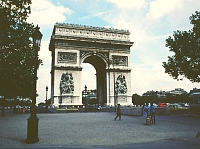
|
The arch from the Neuilly sideThis huge arch (164 feet high, 148 feet long and 72 feet wide) stands at the end of the Avenue des Champs Élysées and in the center of the Place de l'Étoile, formed by the intersection of 12 radiating streets. Although it is much larger, the arch derives from Roman examples. (See, for example, the Arch of Titus.) | |
The arch from the Champs Élysées sideThe structure consists of a simple arch with a vaulted passageway (98 feet high and 49 feet wide) topped by an attic. |
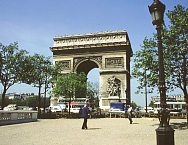
|
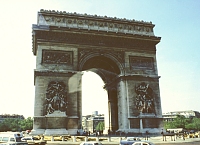
|
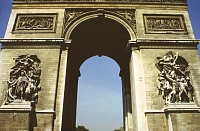
|
The arch from the Champs Élysées sideLeft face of the arch: Cortot's The Triumph of NapoleonRight face of the arch: François Rude's The Departure of the Volunteers of 1792 (or "La Marseillaise") | |
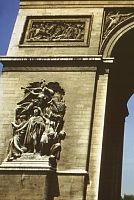
|
Cortot's The Triumph of NapoleonVictory crowns the togaed Napoleon with a laurel wreath while a town surrenders at his feet, History inscribes the names of the battles won on a stone tablet, and Fames blows a trumpet. | |
Rude's The Departure of the Volunteers of 1792 (or "La Marseillaise")The most famous of the four reliefs on the faces of the arch flanking the opening, this emotional composition depicts the French people rallying against enemies from abroad. (Rude's own father had been one of these volunteers.) These citizens, both nude and in classical armor, are roused to patriotic fervor by the Roman goddess of war, Bellona, who has also been identified as a personification of Liberty. This grouping so aroused spectators' patriotism that the work became known as "La Marseillaise," the French national anthem written in 1792--the same year as the departure of the volunteers. |
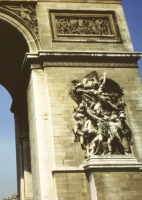
| |
| Sculptures by Etex on the Neuilly side Center: Peace with a man, protected by Minerva, putting his sword back into his scabbard; at his side peasants get back to work; Right: Resistance with a naked soldier defending his family, urged on by the spirit of the future |

|
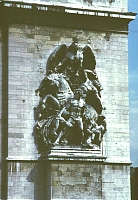
|
| Above these groupings on the faces of the arch are bas reliefs in rectangular frames. These on the Neuilly side depict the capture of Alexandria (left below) with Kléber, hand held to his wounded head, standing on the city walls, urging his troops forward. The first to reach the walls, a grenadier, has bayonetted the Turk who wounded the General. Sculpted by Chaponnière. The right hand bas-relief (center below) depicts the crossing of the Arcole Bridge. Napoleon, with the drummer boy André Etienne, advances against the Austrians, even though Colonel Muiron has just been wounded and tries to prevent the charge. "Soldiers are running behind their general whose profile stands out quite clearly against the folds of the flag" (Dillange 13). Sculpted by Feuchère. There are different scenes on the frieze of the entablature. The Neuilly side (below) illustrates the return of the army, with Peace and Abundance crowning the men. Some soldiers bring back booty, including a sphinx on a cart (left below). The attic is decorated with 30 shields, each of which is inscribed with the name of a victory. Pilasters with sabres and palmettes alternate with the shields. The parapet has sculptured heads of Medusa. | ||
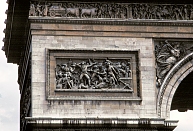
|

|
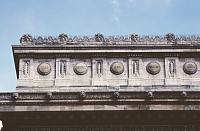
|
 Click here to return to index of art historical sites.
Click here to return to index of art historical sites.
 Click here to return to index of artists and architects.
Click here to return to index of artists and architects.
 Click here to return to chronological index.
Click here to return to chronological index.
 Click here to see the home page of Bluffton College.
Click here to see the home page of Bluffton College.
